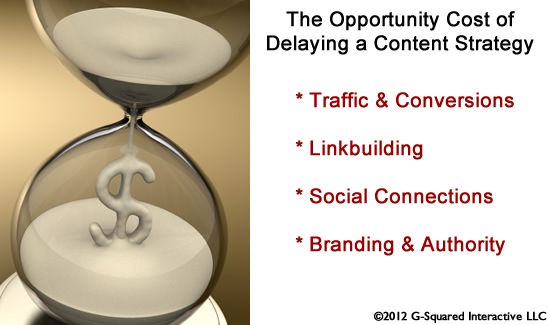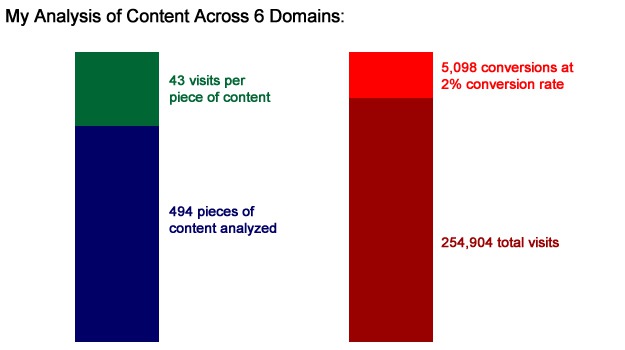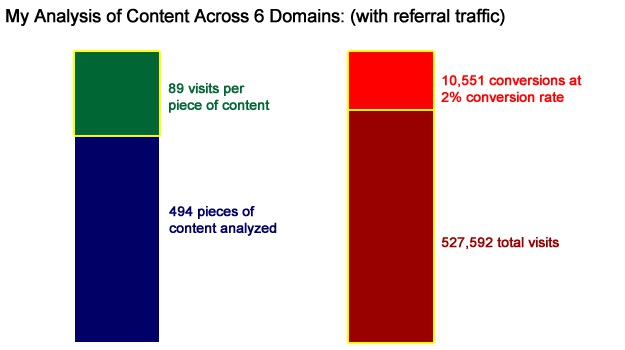For companies looking to build strong SEO results, continually publishing high-quality content is critically important. In a world where Pandas feed on low-quality, thin, or duplicate content, you must strive to build ultra-valuable, world-class content. For some businesses, the challenge in achieving this lies in resources since it takes time and people to produce outstanding content. I totally get that, and you must be realistic with expectations, but there are times when companies have the resources to move quickly, but they delay implementing a content generation strategy due to other, less understandable reasons, and that delay can cost a company dearly from an SEO standpoint.
So what could delay implementing a content generation strategy other than resources or people? Unfortunately, many marketers face internal company challenges that can kill their efforts. For example, there are too many chiefs trying to dictate marketing strategy, the legal department gets involved with every piece of content that needs to be published, committees must vote on what should be published, executives fear losing thought leaders to the competition or writing something controversial, etc. You should read my post about large-scale SEO and failure to learn more about these problems.
Needless to say, while some organizations go back and forth debating their content strategy, some of their competitors won’t. Those competitors might be driving forward, and they could end up running circles around companies that delay their content plan. That’s why I believe it’s extremely important for businesses to understand that the opportunity cost of delaying a content strategy is huge, and it could end up hurting them severely long term.
An Example of a Strong Content Plan Building Organic Search Traffic over Time:

Introduction to Opportunity Cost for SEO
Investopedia defines opportunity cost as:
The cost of an alternative that must be forgone in order to pursue a certain action. Put another way, the benefits you could have received by taking an alternative action.
For SEO, the opportunity cost of delaying a content generation strategy is the loss of rankings, targeted traffic, and sales that the new content could have produced. There are also additional “costs” that could be evaluated, such as increasing social connections, link building, and branding in the industry. I’ll cover each of these components below in greater detail.

1. Lost Traffic and Conversions
The first, and most important, cost is the loss of targeted traffic and conversions. Developing high-quality, killer content that helps prospective customers is an outstanding way to attract a targeted audience, but if you don’t even get to the publishing stage for that content, then you can’t possibly reap the benefits of a strong content plan.
As you drive targeted traffic to your site via organic search, you have a chance at converting a percentage of that traffic. In addition, since there’s no ad spend for that traffic, it’s an extremely cost-effective strategy. Sure, you will spend money on time, resources, people, etc. to develop the content, but the traffic is residual. You will not pay for each visitor to your site like you would with paid search, social advertising, display advertising, etc.
But How Much Traffic Can a Company Expect?
I get this question all the time, and the answer varies based on a number of factors. SEO power is not the same across companies, domains, etc., so it’s hard to determine the traction that new content will gain for each company. That being said, experience shows that building high-quality content over time can build links, SEO power, domain authority, free targeted traffic, and sales.
But you want actual numbers. I get it, and I’ve done some research to gather some numbers for you. Sure, what I’m going to present below isn’t perfect, but you can at least get a feel for a real example of how a strong content plan led to targeted visitors and conversions across several domains.
494 Pieces of Content Across Six Domains
To help demonstrate the opportunity cost using real data, I started analyzing content across a number of different domains that I manage. My goal was to identify content that was produced as part of a strong content generation strategy and then determine how many keywords those pages ranked for and how much traffic those pages received in an average month. I analyzed a range of websites with varying levels of SEO power. Some had moderate levels of SEO power, while others had much more power.
Just to clarify, I’m referring to executing a smart and well-researched content generation strategy. That’s a strategy driven by data, not pure intuition. This includes conducting the proper keyword research, performing content and competitive analyses, and analyzing social data before pulling the trigger on producing content.
The Data:
I analyzed 494 pieces of content across six domains (across different industries). As I mentioned earlier, these posts were part of a well-researched content generation strategy. I excluded posts that were not part of the plan. I analyzed the number of keywords leading to each post during an average month and the number of visits. Since conversion goals across the domains were not similar and included different actions, it was hard to average those percentages. For example, conversion rates vary across e-commerce, lead generation, contact form submissions, downloads, etc. If you want to use these numbers to estimate your own content plan, then you’ll need to plug in your own conversion rate.
What I Found:
The Average Number of Monthly Visits per Post Was 43
It was great to go back through all of the posts to see the keywords and the traffic leading to them. The intelligence you can gain from analyzing this data is amazing, and it can absolutely drive more ideas and content. Some of the content I analyzed is driving hundreds of visits per month, while other pieces of content were much lower (between 25 and 50 visits per month). But that’s okay if you are continually building new content since the aggregate visits and performance will make the difference. You can’t hit a home run every time.
The Collective Value of Content
Collectively, the 494 pieces of content are driving 254,904 visits per year based on my analysis, and that’s across 12,810 different keywords. Actually, it’s more than that number since “not provided” can’t be broken down easily. Depending on the conversion rate used, this traffic is driving thousands of conversions per year with no ad spend. For example, if you used a 2% conversion rate, that equates to 5,098 conversions. Multiply that by the average sale value, and you can see how important that traffic is.

In addition, as you build more content over the second year, third year, etc., the opportunity cost gets greater and greater. Since SEO is residual, you can realistically maintain rankings for an extended period of time, which drives more targeted visits and revenue.
Again, this is just one example of how a content plan is impacting traffic and conversions. I’m not saying this will hold for every company or industry, but there’s also a chance you could exceed what I’ve listed here.
2. Link Building
The opportunity cost does not stop at pure traffic and conversions. If a company delays a content generation strategy, then it will almost certainly miss out on building links, and that can directly impact the SEO strength of the site long term.
If a company develops a strong content generation strategy, uses social media marketing (correctly) to get the word out, builds a strong in-house email list, builds RSS subscribers, etc., then there’s a good chance that their new content will build links over time, and when it does, the SEO strength of the site can build over time. That will help future content rank better by building domain authority.
Adding Referral Traffic
And let’s not forget the ongoing referral traffic from those links, which can bring even more targeted traffic for free. What I listed earlier is only traffic directly from organic search. As your content builds links, those links can start to drive high-quality referrals to your new content.
I analyzed the referral traffic to the posts I reviewed for this example and found that the additional traffic bumped up the number of visits per post to 89 per month. That’s up from 43 visits per month directly from organic search. When you add this to our calculation, the 494 posts I mentioned earlier are driving 527,592 visits on an annual basis. At a 2% conversion rate, that equates to 10,551 conversions. The opportunity cost has grown, right?

New content helps SEO, which helps build links and referrals, which, when combined, can be a significant amount of targeted traffic.
3. Social Connections
I can’t emphasize enough how important it is to build a strong social following. And, no, you won’t do that by simply setting up your accounts and tweeting two updates a day that are all about your own products or services. Connecting with others in your industry and then engaging and helping them can pay huge dividends down the line. Let’s not forget the growing importance of social signals for SEO. For example, you should read my post about Google+ and Search Plus Your World to gain a better understanding of the impact of personalized search.
One of the best ways to build a strong following is to earn respect, likes, shares, etc. by impressing others in your niche with insightful and valuable content. To me, the best type of connection is one that is earned and not requested. As you start to gain visits and readers, it’s completely normal and expected to have a certain percentage of that traffic reach out to you across social networks, including Twitter, Google+, LinkedIn, and Facebook. In addition, you will start to gain RSS subscribers and email subscriptions if you also have an email newsletter.

As you build strong connections, it will be easier to get the word out about your new content by leveraging your social network. Twitter, Facebook, and G+ can absolutely jump start your content sharing. If you’ve ever tried to get the word out about something without a social following, then you know the severe challenges you face. Social connections in your industry can get your content in front of influencers, possibly on a global scale, and producing killer content is a great way to grow your social network.
4. Branding and Becoming an Authority
The last item I’m going to mention relates to building a strong brand company-wise and personally. As employees of a company build top-notch content, there’s a branding component that kicks in on both a company and a personal level. For example, consumers, prospective customers, or others in your industry might start connecting your brand name with outstanding advice and content, while also tying that feeling to the employees who are writing the content. This can yield incredible results from a conversion standpoint. And this is coming from a performance marketer! Yes, I believe that branding and authority translate to sales.
Summary – Fear the Opportunity Cost
If you are part of a company weighing the benefits of launching a strong SEO strategy, then I hope this post helped you understand the opportunity cost of delay. Specifically, you need to build content over time to reap the benefits of SEO, and you can’t publish just any content. It needs to be well-researched, high-quality, killer content that can turn heads, build followers, drive targeted visits, and increase sales. But you can’t do any of that unless you start. So start now.




